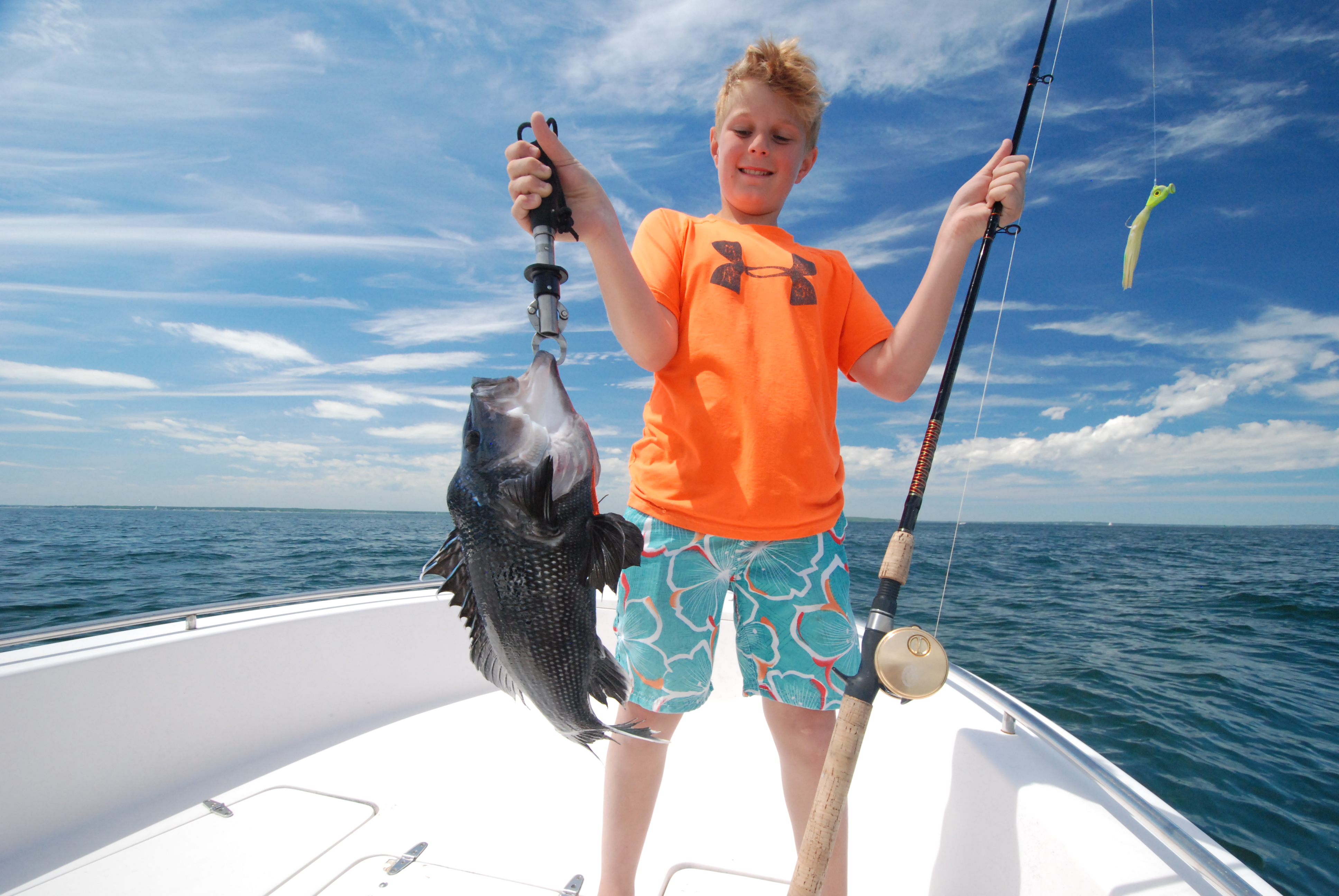Each spring, black sea bass invade the inshore waters of Massachusetts and Rhode Island, providing a great opportunity to catch a batch of these aggressive, great-tasting fish!
When it comes to catching fish, it doesn’t get any easier than black sea bass. The best time to target these tasty, scrappy critters is from late May to mid-June, when the adult fish congregate to spawn in depths of 10 to 40 feet. Once you find a bunch of sea bass over a patch of hard bottom, it doesn’t take long to catch dinner.

Gear Up
Fishing for sea bass doesn’t require expensive or heavy gear. I prefer a 6 ½’ to 7’ rod with a light, sensitive tip and rated for 15- to 30-pound line. I match this with small conventional or spinning reel filled with 20- to 30-pound-test braided line. Braid is great for this type of fishing because it has no stretch, which makes it easy to feel the jig tapping bottom, as well as any subtle strikes. Braid is also thinner than mono of the same breaking strength, so it’s less affected by current in deep water. I tie the main line to a small barrel swivel, followed by 3’ to 4’ of 40-pound-test fluorocarbon leader.
While a strip of squid fished on a plain 3/0 or 4/0 circle hook works well for sea bass, you may end up hooking a lot of sea robins, skate, dogfish, cunner, and scup. That’s one reason why I prefer to use lures. One of the best sea bass lures is a simple bucktail jig. I prefer a SPRO or similar bucktail “sweetened” with a 3” to 4”, pennant-shaped strip of fresh squid. I split the end of the strip to give it more action and to keep it from snagging on the hook during the jigging process.

Watch the Buzzards Bay Black Sea Bass episode of New England Fishing TV!
Sea bass aren’t too fussy about color, but I’ve had the best luck with white, pink/white, chartreuse/white and blue/white patterns. A 2- to 3-ounce jig is ideal when fishing in 20’ to 40’ of water in moderate wind and current. Faster drifts and deeper water may require jigs of up to 4 ounces, but I don’t like to go heavier than that. If you need to slow your drift, deploy a drift sock or even a 5-gallon bucket tethered to a dock line. Anchoring is another option if you find a concentration of fish.

Diamond jigs and other metal jigs such as Daddy Macs (pictured at left), Hopkins and KastMasters also work very well on sea bass, and you often don’t need to add any natural bait to the hook if the fish are thick. Simply lower the jig (2 to 3 ounces is usually ideal) to the bottom and hop it up and down and you drift along.
Another productive and popular rig is the high-low setup. This rig features a heavy jig or bank sinker tied to the end of the leader, with a second hook (3/0 to 5/0 Octopus) attached to a dropper loop roughly a foot above that. The upper hook is baited with a long strip of squid or a small bucktail sweetened with squid.
Prospecting for Sea Bass
Locating a likely sea bass hot spot is usually easy. In my local waters—Buzzards Bay—I look for a large section of fairly flat, hard bottom in 20’ to 40’ of water, although it is possible to find the fish in even shallower spots. I prefer to drift rather than anchor, because drifting lets me cover more bottom to find a concentration of fish. I try to pick a calm day with moderate current. The slower the drift, the easier it is to keep the fishing line as vertical as possible and the jig close to the bottom. The latter is critical, because sea bass won’t usually leave the bottom to chase a jig (although I have caught them on topwater lures aimed at false albacore!).
Once you’ve positioned the boat upwind or upcurrent of the area you want to fish, free-spool your jig to the bottom, reel in one or two turns, and start jigging. Holding the rod tip close to the water and making sharp, short lifts of the tip is most effective. The idea is to make the jig look like a small fish or squid darting or hopping just above the bottom.
Sea bass often hit the jig as it falls toward the bottom, so be ready to set the hook with a quick lift of the rod if you feel a slight tap or tug on the line. Once you hook up, mark the spot on your chartplotter or toss out a marker buoy, as there are sure to be more fish in the same area.
If you don’t score on your first drift, move to a new spot. This is where the track feature on a chartplotter comes in handy, because it lets you cover the bottom systematically. If you don’t score after a few drifts, pick up and try shallower or deeper areas until you find the fish. In sea bass fishing, as in many types of fishing, it pays to fish and move.

Anchoring Tricks
It should be noted that anchoring also works, especially if you find a concentration of fish. In this case you’ll need to drop anchor well upwind or upcurrent of the hot spot and drift back over the fish. If you don’t hook up in the first 5 minutes, reset the anchor or let out or take up anchor line.
As mentioned, May and June are the prime months for sea bass fishing in shallow water. In summer, the bigger fish move out to deeper, cooler water (60 feet or more), where they take up station over wrecks and rock piles. Smaller sea bass can be caught inshore through the summer, in water ranging from 20’ to 50’ deep, but most will be of sublegal size and will need to be released.
Of course, large sea bass can surprise you from time to time—such as the 5-pounder I hooked a few years ago while trolling a swimming plug for bluefish in late August. It seems that black sea bass refuse to be ignored, and they sure have my attention.




